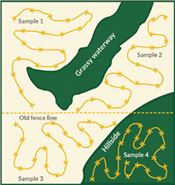Know Your Number. This Spring, Take Advantage Of FREE SCN Egg Counts
DR. KAITLYN BISSONNETTE
COLUMBIA, MO.
Spring planting season is right around the corner which means it is time to start preparing for spring SCN sampling in fields going into soybeans. As SCN is the number one yield reducing disease of soybeans in the Midwest, knowing your number is the first step in implementing an effective nematode management strategy in your fields. Remember, SCN numbers can increase even when resistant soybeans are planted.
Additionally, yield losses as high as 30 percent can be observed in fields where no above ground symptoms have been present, so it is important to consider sampling fields that have not been sampled within the past 3-5 years or those whose history of SCN is unknown.
The best way to sample a field is to divide it into 20- to 40-acre management zones. This could mean areas that are on hillsides versus low lying areas versus historically low yielding areas (Figure 1). A field also can be divided into areas where soil types differ or areas that may have flooded recently. In each zone, take 20 soil cores 6-8 inches deep in a zig-zag pattern and thoroughly mix the cores together into one composite sample per zone. It is best to bring a bucket to aid in the mixing process. Be sure to keep records of the crop rotation and other pertinent field details for each sample. More information on how to sample for SCN can found at TheSCNCoalition.com or on the SCN Diagnostics website at SCNdiagnostics.com.
Currently, FREE checkoff supported SCN egg processing (two samples per farmer) is available through MU Extension by contacting your local extension office or the SCN Diagnostics lab directly at scndiagnostics@missouri.edu or 573-884-9118. Sample submission forms are available on the SCN Diagnostics website scndiagnostics.com . ∆
DR, KAITLYN BISSONNETTE: Department of plant pathology, University of Missouri

Figure 1 Example of how a field could be divided into management zones.
Adapted from "Scouting and Soil Testing for Soybean Cyst Nematode" from the SCN Coalition, thescncoalition.com.